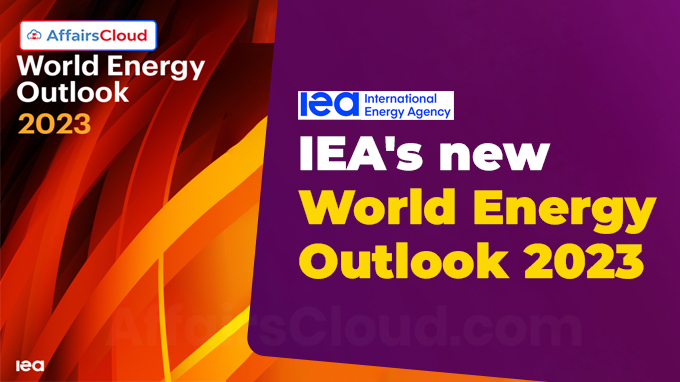
The International Energy Agency (IEA) has released a report, World Energy Outlook 2023, which presents a vision of substantial changes in global energy system by 2030. The report highlights India’s growing electricity demand, with annual growth of around 5%, making it third-largest electricity consumer globally by 2050, after China and the United States. China is the largest electricity consumer in the world.
i.The WEO-2023 presents three scenarios for the future of global energy:
- Stated Policies Scenario (STEPS): This scenario assumes that governments implement the energy policies that have already been announced.
- Accelerated Policy Scenario (APS): This scenario assumes that governments implement more ambitious energy policies in order to achieve climate and other goals.
- Net Zero Emissions by 2050 (NZE): This scenario assumes that global energy-related CO2 emissions reach net zero by 2050, in line with the Paris Agreement.
ii.The report emphasizes that, based on current government policies, global temperatures are still expected to rise by 2.4°C, well above the target set in the Paris Agreement of limiting global warming to 1.5°C.It outlines 5 key pillars to align the world with the 1.5°C target
- Tripling global renewable capacity,
- Doubling the rate of energy efficiency improvements,
- Reducing methane emissions from fossil fuel operations by 75%,
- Establishing innovative financing mechanisms to triple clean energy investments in emerging economies
- Implementing measures for an orderly decline in fossil fuel use.
Fossil fuels is expected to peak by 2025
Global use of fossil fuels is expected to peak by 2025, 2 years earlier than previously anticipated.Fossil Fuels such as Coal, oil, natural gas and bioenergy are each projected to peak before 2030, driven by the rapid growth of low-carbon technologies.Fossil fuels account for close to 80% of total energy supply in 2023.
Investment in Clean Energy:
i.Global investment in clean energy is nearly double that of fossil fuels, and this trend is expected to continue, with clean energy outspending fossil fuels by 2.5 times in 2030.
- IEA suggests that investment needs to nearly triple by the end of the decade to align with the net-zero emissions target outlined in the “APS.” In India is projected to more than double by 2030 compared to 2022 levels, reaching around USD 60 billion.
- Clean energy technologies, focussing on solar photovoltaics (PV) and wind, electric vehicles (EVs), heat pumps, hydrogen and carbon capture, utilisation and storage (CCUS).
iii.Renewables Surge: The report anticipates that the share of renewables in the global electricity mix will reach 50% by 2030, a substantial increase from the current 30%.
- Additionally, the report suggests that the growth of solar photovoltaic (PV) capacity has the potential to outpace current expectations.
- While renewables are projected to contribute 80% of new power generation capacity by 2030, with solar accounting for over half of this expansion, the report posits that the world’s manufacturing capacity for solar panels could exceed 1,200 gigawatts (GW) by the end of the decade, with a deployment of 500 GW in 2030.
- However, by deploying 800 GW of new solar PV capacity by 2030, coal-fired power generation in China could see a further 20% reduction compared to scenarios based on existing policy settings. Moreover, coal and natural gas generation in regions like Latin America, Africa, Southeast Asia, and the Middle East would decrease by a quarter.
- The report anticipates a reduction in natural gas market pressures by 2025 due to the implementation of new liquefied natural gas (LNG) projects.
18 per cent electricity generated in India to be solar by 2030: IEA
The International Energy Agency (IEA) has predicted that 18% of the electricity generated in India will be from solar sources by 2030, which set to be 6% increase in 2023. This is a significant increase, and it reflects the growing importance of solar energy in India’s energy mix.
- According to the report, India is set to become the world’s third-largest solar power generator by 2030, behind China and the United States.
- The report also states that India is on track to achieve its target of installing 500 gigawatts (GW) of renewable energy capacity by 2030.
- India has set a target of achieving 500 GW of installed capacity from non-fossil fuels including around 270 GW of solar capacity, by 2030.
- In the Stated Policies Scenario (STEPS), India dominates in energy demand growth, surpassing Southeast Asia and Africa.
IEA Forecasts India’s CO2 Emission Drop by 2050, Expects AC Electricity Demand to Outpace Africa
i.The IEA’s World Energy Outlook-2023 report predicts a 30% reduction in CO2 emissions from India’s industry and a 25% reduction in CO2 emissions per kilometer driven by passenger cars by 2030.
- This leads to a significant reduction in India’s annual CO2 emissions, which fall by over 40% from current levels by 2050, even as the country’s GDP quadruples over the same period.
ii.India’s demand for electricity to power household air conditioners is expected to increase nine-fold by 2050, surpassing the total power consumption of the entire African continent in 2023, according to the IEA.
- The IEA noted that electricity consumption for cooling increased by 21% between 2019 and 2022. Presently, nearly 10% of India’s electricity demand is attributed to cooling requirements.
- However, in the “APS,” electricity demand for air conditioners is nearly 15% lower in 2050 compared to the STEPS” due to the increased use of energy-efficient air conditioners and thermal insulation in buildings.
- In the “STEPS,” demand for oil and natural gas is anticipated to increase by almost 70% between 2022 and 2050, and coal demand is expected to rise by 10%, even as solar PV gains ground in electricity generation. As a result, India’s annual CO2 emissions are projected to increase by nearly 30% by 2050, which represents one of the largest emissions increases globally.
- Under the Stated Policies Scenario (STEPS), India’s energy supply is estimated to rise from 42 exajoules (EJ) in 2022 to 53.7 EJ in 2030 and 73 EJ in 2050.
IEA’s Upbeat Outlook: Electric Cars to Surge 10-fold by 2030
Based on current policy settings, Electric cars is expected to increase globally by almost 10 times by 2030, highlighting the rapid adoption of electric vehicles on a global scale.
- The IEA expects to see 20% more electric vehicles on the road by 2030 than previously forecasted.
- It notes that electric cars are becoming increasingly prevalent, with 1 in 5 cars sold in 2023 being electric.
IEA Foresees India’s Solar Module Manufacturing Capacity Surpassing 70 GW by 2027
IEA predicts that India’s capacity may exceed 70 gigawatts (GW) annually by 2027. India is committed to expanding its production capacity to meet domestic energy needs and potentially export solar modules.
i.Currently, India holds a 3% share of the global solar PV market and is making substantial progress toward its 2030 goal of sourcing half of its electricity capacity from non-fossil fuel sources well ahead of the end of the decade.
ii.India’s Production Linked Incentive (PLI) scheme, which allocates approximately USD 2.5 billion to boost solar PV module manufacturing, is poised for significant growth in domestic production capacity.
- The IEA’s report suggests that if the new solar PV module manufacturing capacity under the PLI program comes fully online by 2026, it would exceed India’s needs not only in the STEPS but also in the APS.
- In FY22, India imported solar PV modules worth USD3.4 billion.
iii.The global solar manufacturing landscape is highly concentrated, with just 5 countries responsible for over 90% of global capacity.
- China leads the way, capable of producing over 500 GW of solar modules annually, equivalent to 80% of global manufacturing capacity.
- Other key players include Vietnam (5% of the global market), India (3%), Malaysia (3%), and Thailand (2%). The next tier of solar manufacturers, including the United States, South Korea, Cambodia, Turkey, and Chinese Taipei, each contributes around 1% to the global total, similar to the European Union’s share.
About World Energy Outlook:
The annual World Energy Outlook (WEO) is the IEA flagship publication on global energy projections and analysis.
- The first WEO was published in 1977 and it has been an annual publication since 1998.
- This Outlook assesses the evolving nature of energy security fifty years after the foundation of the IEA.
About IEA:
Headquarters: Paris, France
Established: November 1974
Executive Director: Fatih Birol




